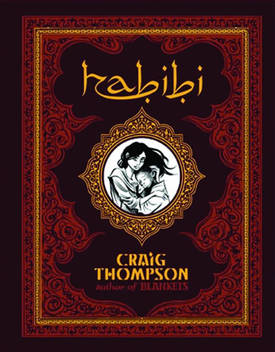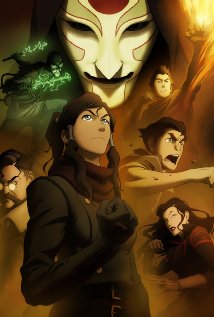
Craig Thompson’s Habibi attracted me from the first glance for its beautiful Islamic-inspired art. He seduced me on every page with patterns and calligraphy, for bringing up the stories I grew up on: the Bible, the Thousand and One Nights, and the stories I have been learning since high school: the stories of the Qu’ran.
Yet throughout Habibi, I became more and more uncomfortable. The art is gorgeous. But the messages and the story are problematic.
The primary issue is our main character, Dodola. She is sexualized completely and her many rapes also sexualized (particularly by Zam, the other major character). The second issue is racism, of course, because it turns out that Craig Thompson is an American with a post-9/11 guilt complex who doesn’t speak Arabic, only writes it. From what I can tell, he knows his Arabic calligraphy well, and is probably accurate as to the Qu’ran and Islamic elements. So he did some research. I wish he’d researched, I don’t know, women, and particularly rural Muslim women and harem women, because even though I don’t know much about women in these situations, I could tell something about their portrayal just wasn’t right.
Dodola at first seemed like an interesting heroine. She is sold at a very young age to her first husband, a calligrapher. He rapes her, but there is some affection and pity in their relationship that I wanted to see more of. He also teaches her to write. I thought, here is a place to explore a very uncomfortable relationship, humanly flawed, tragic and fascinating. How will learning to read and write empower Dodola and shape her? But soon he is killed, and Dodola is seized by some dudes to be sold into a slave market.
Thus starts the continual cycle of Dodola as sexual object. There is an entertaining section where she rescues a black baby (Zam) in a crazy chase through the marketplace, where she ultimately outruns the slavers and flees to the desert to live with Zam. This is the last of feisty empowered Dodola. Afterwards, sex and her body becomes her trade. She sells her body to caravaners for food; her calligraphy is only used to make protective amulets for Zam: mostly she tells stories she remembers learning from her husband. For a good portion of the book, she lives in a decadent harem straight out of Orientalist fantasy.
Ah, yes. Orientalist. After I put down Habibi, I felt terribly conflicted, and I ended up taking a book out of the library trying to alleviate my discomfort: Scheherazade Goes West, by Fatema Mernissi, a Moroccan sociologist, feminist and author.
Scheherazade Goes West seeks to answer the question: why is there such a disjunct between the harem and harem fantasies Fatema Mernissi grew up with versus the Orientalist fantasy exemplified by Ingres’ paintings of odalisques?

It was such an absorbing read, and a quick one, that I read it all in a day. The main thesis of the book is that Eastern and Western male conceptions of what an attractive woman is are entirely different. In the East, men are attracted to women who are mobile and intelligent, but they are afraid of them too, so they lock them up in harems and try to keep them out of the public sphere. Harems are hotbeds of jealousy and intrigues. But the Western ideal of an ideal female is, my terms, one who is stupid, silent and childlike. These male fantasies are on a cultural level, not on an individual one.
Hence the Western conception of the harem being a place full of languid beauties eager to please. Which is exactly what we have in Habibi, by the way: an unsexy sultan (short, portly, and illustrated rather in the style of my least-favourite comics artist, Crumb) that Dodola hates but has sex with anyway because… um… it’s preferable to death I guess. She gets pregnant, has some revelations about motherhood, but then lies around in an opium daze.
So here’s Dodola: she’s defined by sex and motherhood and telling stories (but not writing). Er.
And the harem is exactly like an Orientalist fantasy. Everything is about bodies. Fatema Mernissi writes that caliphs sought out talented women who could sing, write and recite poetry, who were artists and well-spoken, for their harems. Harun al-Rashid, the great Abbasid caliph, wrote (albeit, bad) poetry to his loves. Brains are sexiest, yo. Why the heck is this sultan in Habibi presented this way? He just comes across as a bad knock-off of the sultan in Disney’s Aladdin.

Oh, and Dodola has no interaction with any of the other women. There are no jealous intrigues or close friendships. She has a servant, and the eunuchs are fond enough of her to participate in a plan of hers. There’s some women who don’t like her. I was totally unsatisfied with that. Surely she ends up with some friends?
This reminded me of Jacqueline Carey’s Kushiel’s Avatar, the third book in her first trilogy. Skip this paragraph to avoid spoilers. The main character, Phedre, is captured by a twisted, evil ruler and made the favourite of his zenana (harem). Phedre is a marked by the god Kushiel to be a sacred masochist, basically, so she enjoys the torture the ruler puts upon her, even as she hates it. But they have conversations about more than just sex, and eventually they love each other: Phedre uses this opening to kill him. Meanwhile, in the zenana, she reaches out and makes both friends and enemies with the other women and boys. After the ruler’s downfall, they help each other to bury the dead and heal the wounded. I honestly don’t know if the Kushiel books are great literature or not, but this nuanced, complex approach to a harem and women’s relationships makes Habibi‘s laughable and sad.
So ultimately, I was really disappointed in this book. It just seemed… unapologetically Orientalist with a lamentable female character. Repeat after me: a woman is not just a sex object who births babies. A woman is a human being with desires and dreams that may include sex and children. There’s an interesting note near the end, where Dodola realizes that in wanting a child to nurture, she really wanted to nurture herself, who was stripped of childhood so early.
Then she purchases/rescues a child at a slave market. Why was this not brought out more? That’s interesting! Where’s the story of Dodola nurturing herself and her storytelling/writing abilities?
Clearly in another book, where being a woman isn’t defined by sex organs.
 I didn’t really have high hopes for The Legend of Korra, since it’s not at all my kind of setting. Too modern, a drastic change from the low-tech world of The Last Airbender. However, I had hopes that like its predecessor it would shine in the humour and character development areas.
I didn’t really have high hopes for The Legend of Korra, since it’s not at all my kind of setting. Too modern, a drastic change from the low-tech world of The Last Airbender. However, I had hopes that like its predecessor it would shine in the humour and character development areas.


